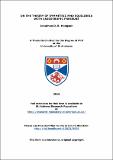On the theory of symmetric MHD equilibria with anisotropic pressure
Abstract
In this thesis we discuss the theory of symmetric MHD equilibria with anisotropic pressure. More
specifically, we focus on gyrotropic pressures, where the pressure tensor can be split into components along
and across the magnetic field. We first explore 2D solutions, which can be found using total field type
formalisms. These formalisms rely on treating quantities as functions of both the magnetic flux function
and the magnetic field strength, and reduce the equilibrium equations to a single Grad-Shafranov equation
that can be solved to find the magnetic flux function. However, these formalisms are not appropriate
when one includes a shear field component of magnetic flux, since they lead to a set of equations which
are implicitly coupled. Therefore, in order to solve the equilibrium problem with a magnetic shear field
component, we introduce the poloidal formalism. This new formalism considers quantities as functions
of the poloidal magnetic field strength (instead of the total magnetic field strength), and yields a set
of two equations which are not coupled, and can be solved to find the magnetic flux function and the
shear field. There are some situations where the poloidal formalism is difficult to use, however, such as
in rotationally symmetric systems. Thus we require a further formalism, which we call the combined
approach, which allows a more general use of the poloidal formalism. One finds that the combined
formalism leads to multi-valued functions, which must be dealt with appropriately. Finally, we present
some numerical examples of MHD equilibria, which have been found using each of the three formalisms
mentioned above.
Type
Thesis, PhD Doctor of Philosophy
Collections
Items in the St Andrews Research Repository are protected by copyright, with all rights reserved, unless otherwise indicated.

